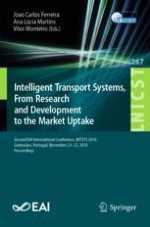2019 | Book
Intelligent Transport Systems, From Research and Development to the Market Uptake
Second EAI International Conference, INTSYS 2018, Guimarães, Portugal, November 21–23, 2018, Proceedings
Editors: Joao Carlos Ferreira, Ana Lúcia Martins, Vitor Monteiro
Publisher: Springer International Publishing
Book Series : Lecture Notes of the Institute for Computer Sciences, Social Informatics and Telecommunications Engineering
